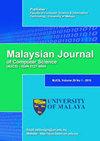NEURAL NETWORK WITH AGNOSTIC META-LEARNING MODEL FOR FACE-AGING RECOGNITION
IF 1.2
4区 计算机科学
Q4 COMPUTER SCIENCE, ARTIFICIAL INTELLIGENCE
引用次数: 0
Abstract
Face recognition is one of the most approachable and accessible authentication methods. It is also accepted by users, as it is non-invasive. However, aging results in changes in the texture and shape of a face. Hence, age is one of the factors that decreases the accuracy of face recognition. Face aging, or age progression, is thus a significant challenge in face recognition methods. This paper presents the use of artificial neural network with model-agnostic meta-learning (ANN-MAML) for face-aging recognition. Model-agnostic meta-learning (MAML) is a meta-learning method used to train a model using parameters obtained from identical tasks with certain updates. This study aims to design and model a framework to recognize face aging based on artificial neural network. In addition, the face-aging recognition framework is evaluated against previous frameworks. Furthermore, the performance and the accuracy of ANN-MAML was evaluated using the CALFW (Cross-Age LFW) dataset. A comparison with other methods showed superior performance by ANN-MAML.基于不可知元学习模型的人脸识别神经网络
人脸识别是最容易接近和访问的身份验证方法之一。它也被用户接受,因为它是非侵入性的。然而,衰老会导致面部纹理和形状的变化。因此,年龄是降低人脸识别准确性的因素之一。因此,人脸老化或年龄进展是人脸识别方法中的一个重大挑战。本文介绍了将具有模型不可知元学习的人工神经网络(ANN-MML)用于人脸衰老识别。模型不可知元学习(MAML)是一种元学习方法,用于使用从具有特定更新的相同任务中获得的参数来训练模型。本研究旨在设计和建模一个基于人工神经网络的人脸衰老识别框架。此外,还对人脸老化识别框架进行了评估。此外,使用CALFW(跨年龄LFW)数据集评估了ANN-MAML的性能和准确性。与其他方法的比较表明,ANN-MML具有优越的性能。
本文章由计算机程序翻译,如有差异,请以英文原文为准。
求助全文
约1分钟内获得全文
求助全文
来源期刊

Malaysian Journal of Computer Science
COMPUTER SCIENCE, ARTIFICIAL INTELLIGENCE-COMPUTER SCIENCE, THEORY & METHODS
CiteScore
2.20
自引率
33.30%
发文量
35
审稿时长
7.5 months
期刊介绍:
The Malaysian Journal of Computer Science (ISSN 0127-9084) is published four times a year in January, April, July and October by the Faculty of Computer Science and Information Technology, University of Malaya, since 1985. Over the years, the journal has gained popularity and the number of paper submissions has increased steadily. The rigorous reviews from the referees have helped in ensuring that the high standard of the journal is maintained. The objectives are to promote exchange of information and knowledge in research work, new inventions/developments of Computer Science and on the use of Information Technology towards the structuring of an information-rich society and to assist the academic staff from local and foreign universities, business and industrial sectors, government departments and academic institutions on publishing research results and studies in Computer Science and Information Technology through a scholarly publication. The journal is being indexed and abstracted by Clarivate Analytics'' Web of Science and Elsevier''s Scopus
 求助内容:
求助内容: 应助结果提醒方式:
应助结果提醒方式:


